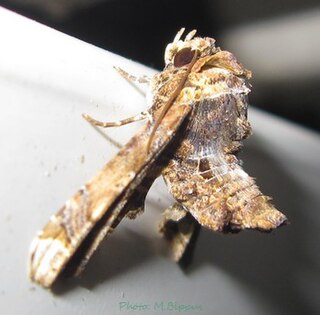Related Research Articles

Urodidae, whose species are commonly known as false burnet moths, is a family of moths in the lepidopteran order. It is the type genus in the superfamily, Urodoidea, with three genera, one of which, Wockia, occurs in Europe.
Metachanda is the sole genus in tribe Metachandini of moth subfamily Oecophorinae. Metachandini was originally described as family Metachandidae by Edward Meyrick in 1911, and at the time also contained the genus Chanystis, which is currently unplaced to tribe within Oecophorinae. It has also previously been described as tribe Metachandini of subfamily Gelechiinae.
Agathiphaga is a genus of moths, known as kauri moths. and is the only living genus in the family Agathiphagidae. This caddisfly-like lineage of primitive moths was first reported by Lionel Jack Dumbleton in 1952, as a new genus of Micropterigidae.

The Thyatirinae, or false owlet moths, are a subfamily of the moth family Drepanidae with about 200 species described. Until recently, most classifications treated this group as a separate family called Thyatiridae.
Prosopidia is a genus of moths in the subfamily Arctiinae.

Eutelia is a genus of moths of the family Euteliidae erected by Jacob Hübner in 1823.

Eutrogia is a genus of moths of the family Erebidae.

Pseudozarba is a genus of moths in the subfamily Eustrotiinae of the family Noctuidae. The genus was described by Warren in 1913.
Tarista is a genus of moths of the family Erebidae. The genus was described by William Schaus in 1913.
Celonoptera is a monotypic moth genus in the family Geometridae. Its only species, Celonoptera mirificaria, is found in south-eastern Europe. Both the genus and species were first described by Julius Lederer in 1862.
Victor Gurney Logan Van Someren was a zoologist and entomologist. Van Someren was born in Australia. He attended George Watson's College and studied zoology at University of Edinburgh. He was also a dentist. Van Someren moved to Kenya in 1912 and lived in Nairobi. He was in the East Africa and Uganda Natural History Society and became Honorary Secretary. In 1930 he became Curator of the Coryndon Museum. Van Someren named a number of bird and butterfly species.

Ichneutica morosa is a moth of the family Noctuidae. It is endemic to New Zealand and is found in the southern parts of the North Island and throughout the South Island. I. morosa is common in the eastern parts of both those islands and also in Fiordland. I. morosa can be found from altitudes ranging from lowlands to the alpine zone. I. morosa is absent from the range of its closely related species I. mustulenta, that is from the northern North Island. The larvae of I. morosa are known to feed on Poa astonii and also on other Poa species including introduced species. As well as its standard form the adult moths have a grey colour morph with the head and thorax being a grey and mottled brown, and the forewing being a pale greyish ochreous to a deep brown, suffused with grey. I. morosa can be confused with I. mustulenta and I. lignana. Adults are on the wing from November to April.
Metarctia morosa is a moth of the subfamily Arctiinae. It was described by Sergius G. Kiriakoff in 1957. It is found in the Democratic Republic of the Congo.
Prosopidia meruloides is a moth in the subfamily Arctiinae. It was described by William Schaus in 1905. It is found in Peru.
Paranigilgia morosa is a moth in the family Brachodidae. It was described by Alexey Diakonoff in 1948. It is found on the Moluccas and in New Guinea.
Givira morosa is a moth in the family Cossidae. It is found in Costa Rica.
Dolecta is a genus of moths in the family Cossidae. It is endemic to the Neotropical biogeographic region.

Euploea morosa is a butterfly in the family Nymphalidae. It was described by Arthur Gardiner Butler in 1866. It is found in the Australasian realm.
References
- ↑ Beccaloni, G.; Scoble, M.; Kitching, I.; Simonsen, T.; Robinson, G.; Pitkin, B.; Hine, A.; Lyal, C., eds. (2003). "Prosopidia morosa". The Global Lepidoptera Names Index . Natural History Museum . Retrieved May 12, 2018.